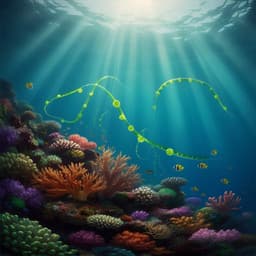
Environmental Studies and Forestry
High concentrations of plastic hidden beneath the surface of the Atlantic Ocean
K. Pabortsava and R. S. Lampitt
Discover the hidden reality of plastic pollution in our oceans through groundbreaking research by Katsiaryna Pabortsava and Richard S. Lampitt. Their findings unveil staggering amounts of small plastic debris lurking in the depths, challenging our understanding of environmental impact and urging us to re-evaluate our response to this pressing issue.
Playback language: English
Introduction
Marine microplastics (10–1000 µm) are a significant part of discarded plastic debris entering the ocean from various sources, including rivers, atmosphere, illegal dumping, erosion of landfills, and direct littering from ships and fishing activities. The widespread presence of microplastics raises concerns about their impact on marine ecosystems and human health. However, current knowledge about the sources, exposure levels, and harm caused by microplastics is limited. Existing data on microplastic loads are geographically sparse and mainly focus on particles larger than 250 µm in surface waters and the seafloor. The abundance and distribution of smaller microplastics (<250 µm) in the ocean interior remain largely unknown, creating a significant knowledge gap. The current mass of floating surface plastics cannot be accounted for by known input fluxes from land and marine sources, highlighting the uncertainty surrounding plastic inputs and the potential for significant, undetected reservoirs of plastic within the ocean. Adding to this uncertainty is the wide variety of plastic materials, necessitating assessment of pollution by polymer type rather than treating plastics as a single material. Different plastics have varying physical and chemical properties, influencing their fragmentation, degradation, aggregation, and interactions within the ocean, impacting their persistence and effect on marine life. This study aimed to assess pollution from polyethylene (PE), polypropylene (PP), and polystyrene (PS) – common plastics used in packaging – across a large area of the Atlantic Ocean, focusing on smaller particle sizes and their penetration into the ocean interior.
Literature Review
Previous studies have documented the presence of microplastics in various marine environments, but these studies have limitations. Geographical coverage of measurements is often sparse, with a bias towards larger plastic particles (>250 µm) in surface waters and seafloor samples. Data on the abundance and distribution of microplastics, particularly those smaller than 250 µm, within the vast ocean interior, are limited, with the exception of a single deep-sea survey in the Arctic. This lack of comprehensive data leads to an inability to balance the mass of observed ocean plastics with estimates of plastic input from various sources. Existing estimates of plastic input into the ocean are also massively uncertain, necessitating robust global assessments. Furthermore, the diversity of plastic materials complicates the issue, requiring analysis by polymer type rather than treating all plastics uniformly. Different plastic types exhibit vastly different physical and chemical properties, impacting their behavior and persistence in the ocean.
Methodology
To assess the pollution from polyethylene (PE), polypropylene (PP), and polystyrene (PS) microplastics, the researchers collected samples from twelve locations along a 10,000 km North-South transect in the Atlantic Ocean. In situ stand-alone pumps (SAPs) were deployed simultaneously at three depths: 10 meters below the surface, approximately 10–30 meters below the mixed layer depth (MLD), and 100 meters below the intermediate depth. The MLD varied between 28 and 140 meters depending on the location. All sampling and processing steps were performed in controlled environments to prevent contamination. Large volumes of seawater were filtered (507–1534 L per SAP) using pre-combusted stainless-steel and nylon meshes. Particulate organic matter was removed using KOH, and microplastics were pre-concentrated on a stainless-steel mesh with a 25 µm aperture. Polymer type and size were identified using Fourier-Transform infrared (FTIR) imaging at 25 µm resolution. The concentrations of polymer-specific microplastics were reported as particle numbers per unit volume (particles m⁻³) and mass concentrations (µg m⁻³), with the latter calculated using two-dimensional particle properties and assumptions about particle shape, thickness, and density. The most conservative estimates of mass concentrations were reported to provide a cautious assessment. Procedural blanks were used to ensure the absence of contamination during sampling and analysis. No PE, PP, and PS microplastics were detected in the blanks, indicating contamination-free sampling and analysis.
Key Findings
PE, PP, and PS microplastics were found at all stations, with concentrations varying horizontally and with depth. PE was the most abundant polymer type, followed by PP and then PS. Microplastic sizes ranged from 32 to 651 µm, with a majority (<100 µm) in the 50–75 µm range. Elevated concentrations were found in near-surface waters, but substantial quantities were also present below the MLD. The average abundance of PE and PS microplastics was comparable in surface and subsurface waters (below the MLD), although mass concentrations declined with depth more rapidly for PS than PE. PP microplastics showed the lowest concentrations at the intermediate depth. The study detected much higher near-surface abundances of PE, PP, and PS than previously reported in the Atlantic. While the near-surface abundances were comparable to previous wind-corrected estimates, the subsurface abundances were significantly higher. The combined mass of PE, PP, and PS microplastics (32–651 µm) in the upper 200 meters of the Atlantic Ocean was estimated to be 11.6–21.1 million tonnes (MT), comprising 6–14 MT of PE, 4–5 MT of PP, and 0.95–1.6 MT of PS. This estimate is significantly higher than previous estimates of larger plastic debris in the Atlantic. There was no clear increase in subsurface microplastic abundance in subtropical gyres. High concentrations near South Georgia were likely advected from other areas or resulted from local fishing activities. PS showed a significant southward decrease in surface mass abundance, possibly due to lower production and consumption in the Southern Hemisphere. The study found that smaller microplastics (<100 µm) were prevalent at all locations suggesting that horizontal dispersal and loss into the ocean interior are size-selective processes. The vertical distribution of these polymers was heterogeneous suggesting varied supply, distribution, and fate, influenced by complex oceanic processes.
Discussion
This study's depth-resolved, polymer-specific data reveals that smaller microplastics have been severely underestimated in previous assessments of marine plastic pollution and that considerable quantities of microplastics are present in the ocean's interior. The findings address the existing conundrum of 'missing' ocean plastics by demonstrating that previous assessments were insufficient in terms of particle size and water depth sampled. The high quantities of small microplastics in the upper 200 meters of the Atlantic, estimated at 11.6–21.1 MT, represent a significant contribution to the overall plastic burden. This significantly impacts previous estimations of the Atlantic's plastic budget, indicating that previous estimates of plastic inputs were substantial underestimates. Potential reasons for this discrepancy include underestimation of land-based inputs, neglect of atmospheric and maritime inputs, and an incomplete accounting of smaller microplastics (<300 µm) in previous models and studies. The study emphasizes the need for improved methods of sampling and detecting smaller plastics and for more robust estimations of plastic inputs to the ocean, including microplastics and nanoplastics.
Conclusion
This study demonstrates that the ocean's subsurface harbors significant quantities of small microplastics, far exceeding previous estimates. The high concentrations of PE, PP, and PS found in the Atlantic's upper 200 meters reconcile the previously reported 'missing plastic' paradox. This finding highlights the limitations of previous assessments and underscores the critical need for more comprehensive assessments that include smaller-sized microplastics across all polymer types to accurately determine the true extent of ocean plastic pollution. Future research should focus on refining input estimates, developing improved methods for detecting smaller microplastics (including nanoplastics), and investigating the long-term fate and impacts of microplastics in the deep ocean and sediments.
Limitations
The study's limitations include the size range of particles measured (32–651 µm), the assumptions made in converting 2D images to mass concentrations, and the spatial and vertical variations in plastic abundance and distribution across the Atlantic. While the study provides a conservative minimum estimate, it does not account for all plastic types or sizes, including nanoplastics. The spatial extrapolation of the data to the entire Atlantic basin introduces uncertainty, as does the assumption of consistent plastic input rates over time. Further research is needed to quantify the contribution of plastic types and sizes not included in this study and to better understand spatial variability.
Related Publications
Explore these studies to deepen your understanding of the subject.







